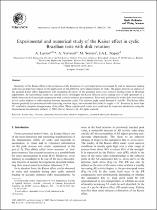 ResearchSpace
ResearchSpace
Experimental and numerical study of the Kaiser effect in cyclic Brazilian tests with disk rotation
JavaScript is disabled for your browser. Some features of this site may not work without it.
- ResearchSpace
- →
- Research Publications/Outputs
- →
- Journal Articles
- →
- View Item
| dc.contributor.author |
Lavrov, A

|
en_US |
| dc.contributor.author |
Vervoort, A

|
en_US |
| dc.contributor.author |
Wevers, M

|
en_US |
| dc.contributor.author |
Napier, JAL

|
en_US |
| dc.date.accessioned | 2007-02-07T13:31:20Z | en_US |
| dc.date.accessioned | 2007-06-07T10:10:11Z | |
| dc.date.available | 2007-02-07T13:31:20Z | en_US |
| dc.date.available | 2007-06-07T10:10:11Z | |
| dc.date.issued | 2002-04 | en_US |
| dc.identifier.citation | Lavrov, A, et al. 2002. Experimental and numerical study of the Kaiser effect in cyclic Brazilian tests with disk rotation. International Journal of Rock Mechanics and Mining Sciences, vol 39(3), pp 287-302 | en_US |
| dc.identifier.issn | 1365-1609 | en_US |
| dc.identifier.uri | http://hdl.handle.net/10204/1586 | en_US |
| dc.identifier.uri | http://hdl.handle.net/10204/1586 | |
| dc.description.abstract | Sensitivity of the Kaiser effect to the deviations of the directions of sigma(1)-principal stress experienced by rock in Successive loading cycles has an important impact on the application of this effect for stress measurements in rocks. The paper presents an analysis of the gradual Kaiser Effect degradation with increasing deviation of the principal stress axes between loading cycles in Brazilian experiments. An experimental study was carried out to investigate the Kaiser effect in cyclic loading tests of disk specimens of a brittle limestone in diametrical compression with acoustic emission measurement. Tests were performed in which disks were loaded in two cycles without of with rotations between successive cycles. The rotation angle varied between 0degrees and 90degrees. The Kaiser effect became gradually less pronounced with increasing rotation angle, but remained detectable for angles < 10degrees. Rotation by more than 10degrees resulted in complete disappearance of the effect. These experimental results were confirmed by numerical simulations using the displacement discontinuity method. | en_US |
| dc.format.extent | 554240 bytes | en_US |
| dc.format.mimetype | application/pdf | en_US |
| dc.language.iso | en | en_US |
| dc.publisher | Pergamon-Elsevier Science Ltd | en_US |
| dc.rights | Copyright: 2002 Elsevier Science Ltd. | en_US |
| dc.subject | Kaiser effect | en_US |
| dc.subject | Rock fractures | en_US |
| dc.subject | Limestone | en_US |
| dc.subject | Principal stress direction | en_US |
| dc.subject | Brazilian tests | en_US |
| dc.title | Experimental and numerical study of the Kaiser effect in cyclic Brazilian tests with disk rotation | en_US |
| dc.type | Article | en_US |
| dc.identifier.apacitation | Lavrov, A., Vervoort, A., Wevers, M., & Napier, J. (2002). Experimental and numerical study of the Kaiser effect in cyclic Brazilian tests with disk rotation. http://hdl.handle.net/10204/1586 | en_ZA |
| dc.identifier.chicagocitation | Lavrov, A, A Vervoort, M Wevers, and JAL Napier "Experimental and numerical study of the Kaiser effect in cyclic Brazilian tests with disk rotation." (2002) http://hdl.handle.net/10204/1586 | en_ZA |
| dc.identifier.vancouvercitation | Lavrov A, Vervoort A, Wevers M, Napier J. Experimental and numerical study of the Kaiser effect in cyclic Brazilian tests with disk rotation. 2002; http://hdl.handle.net/10204/1586. | en_ZA |
| dc.identifier.ris | TY - Article AU - Lavrov, A AU - Vervoort, A AU - Wevers, M AU - Napier, JAL AB - Sensitivity of the Kaiser effect to the deviations of the directions of sigma(1)-principal stress experienced by rock in Successive loading cycles has an important impact on the application of this effect for stress measurements in rocks. The paper presents an analysis of the gradual Kaiser Effect degradation with increasing deviation of the principal stress axes between loading cycles in Brazilian experiments. An experimental study was carried out to investigate the Kaiser effect in cyclic loading tests of disk specimens of a brittle limestone in diametrical compression with acoustic emission measurement. Tests were performed in which disks were loaded in two cycles without of with rotations between successive cycles. The rotation angle varied between 0degrees and 90degrees. The Kaiser effect became gradually less pronounced with increasing rotation angle, but remained detectable for angles < 10degrees. Rotation by more than 10degrees resulted in complete disappearance of the effect. These experimental results were confirmed by numerical simulations using the displacement discontinuity method. DA - 2002-04 DB - ResearchSpace DP - CSIR KW - Kaiser effect KW - Rock fractures KW - Limestone KW - Principal stress direction KW - Brazilian tests LK - https://researchspace.csir.co.za PY - 2002 SM - 1365-1609 T1 - Experimental and numerical study of the Kaiser effect in cyclic Brazilian tests with disk rotation TI - Experimental and numerical study of the Kaiser effect in cyclic Brazilian tests with disk rotation UR - http://hdl.handle.net/10204/1586 ER - | en_ZA |





